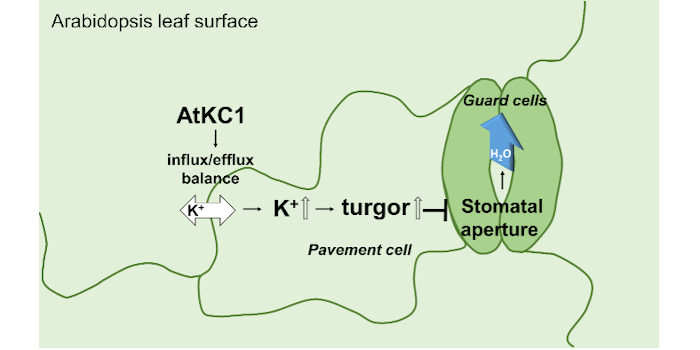Putting limits to water loss: A K+ channel subunit is involved in the control of stomatal aperture by pavement cells
Author et al. explore the non-autonomous mechanism controlling stomatal aperture
https://doi.org/10.1093/plcell/koac038
Manuel Nieves-Cordones, Biochimie et Physiologie Moléculaire des Plantes, UMR BPMP, Univ Montpellier, CNRS, INRAE, Montpellier SupAgro, Montpellier 34060, France. Present address: Departamento de Nutrición Vegetal, CEBAS-CSIC, Campus de Espinardo, 30100 Murcia, Spain
Hervé Sentenac, Biochimie et Physiologie Moléculaire des Plantes, UMR BPMP, Univ Montpellier, CNRS, INRAE, Montpellier SupAgro, Montpellier 34060, France
Background: The water that plants absorb from the soil is mainly lost through evaporation at the leaf surface across microscopic pores called stomata. On the other hand, these pores also allow the diffusion of CO2 from the atmosphere to the internal tissues for photosynthesis. Stomata are surrounded by two specialized cells, called guard cells. Changes in guard cell turgor allow them to swell or shrink for enlarging or narrowing the pore. This control is aimed at preventing excessive water loss. Gaining knowledge on the underlying mechanisms will provide tools to optimize water use by plants.
Question: The epidermal cells surrounding the guard cells, called pavement cells, form an anatomical obstacle that limits the movement of the guard cells. Their turgidity exerts a counter-pressure on the guard cells that opposes stomatal opening. The molecular mechanisms underlying this non-autonomous control of stomatal aperture by guard cells are poorly understood.
Findings: We show that disruption of the Arabidopsis thaliana K+ channel subunit gene AtKC1 reduces pavement cell turgor, due to decreased K+ accumulation, without affecting guard cell turgor. This results in a decrease in the back-pressure of pavement cells onto guard cells. The atkc1 mutation increases the sensitivity of the pavement cell membrane electrical potential to external K+, revealing an impaired control of K+ transport properties. Restoration of the wild-type stomatal phenotype requires expression of AtKC1 in the pavement cells but also in another epidermal cell type, the trichomes. Thus, the whole epidermis appears to contribute to the non-autonomous control of transpirational water loss.
 Next steps: The family of K+ channels to which AtKC1 belongs is strongly conserved in plants and comprises AtKC1 homologs in every species. Whether the present information is translatable to crops should be investigated. The role of trichomes in regulating stomatal aperture via AtKC1 also deserves further research.
Next steps: The family of K+ channels to which AtKC1 belongs is strongly conserved in plants and comprises AtKC1 homologs in every species. Whether the present information is translatable to crops should be investigated. The role of trichomes in regulating stomatal aperture via AtKC1 also deserves further research.
Manuel Nieves-Cordones, Farrukh Azeem, Yuchen Long, Martin Boeglin, Geoffrey Duby, Karine Mouline, Eric Hosy, Alain Vavasseur, Isabelle Chérel, Thierry Simonneau, Frédéric Gaymard, Jeffrey Leung, Isabelle Gaillard, Jean-Baptiste Thibaud, Anne-Aliénor Véry, Arezki Boudaoud and Hervé Sentenac. (2022). Non-autonomous stomatal control by pavement cell turgor via the K+ channel subunit AtKC1. Plant Cell. https://doi.org/10.1093/plcell/koac038



